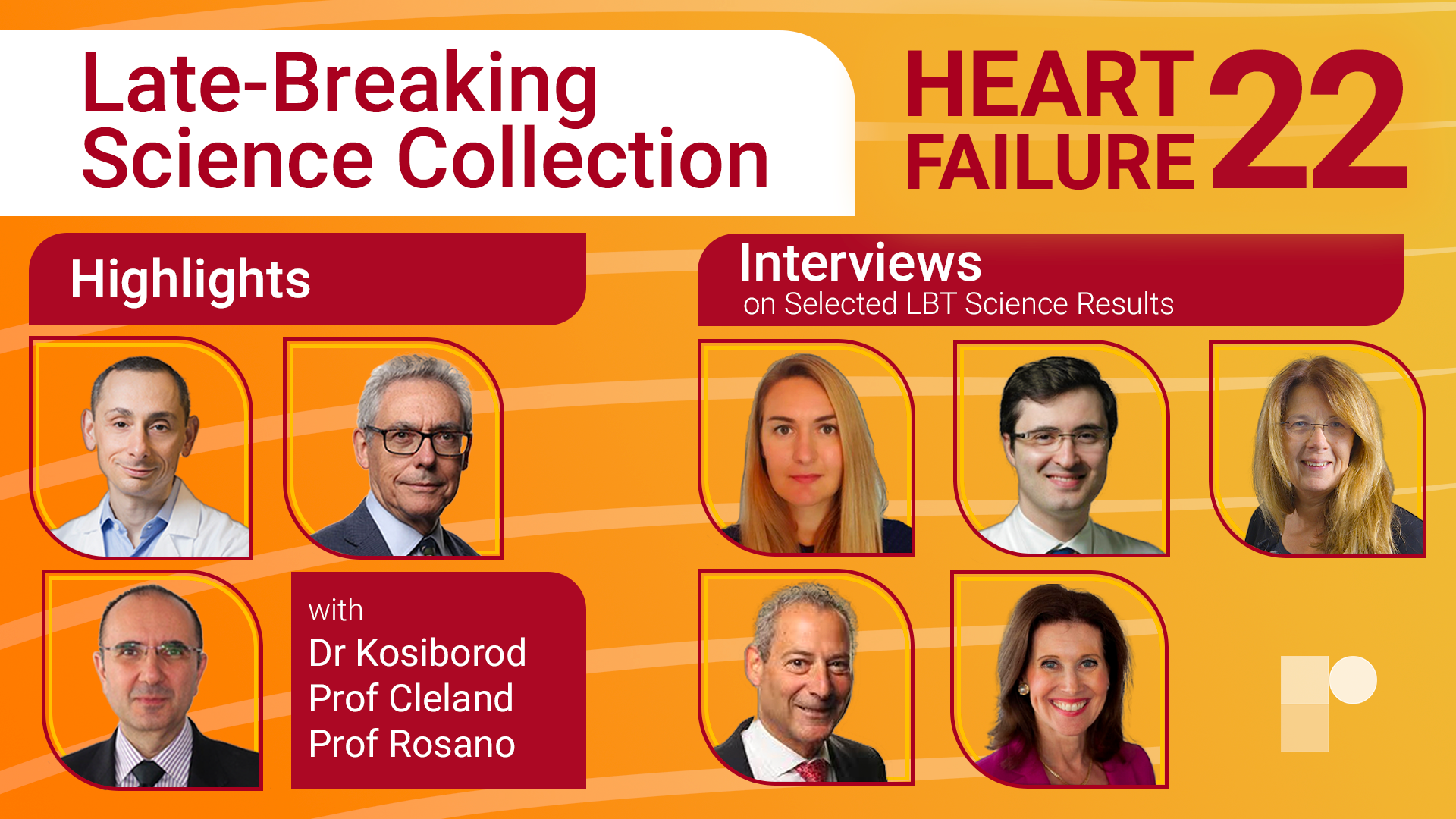Heart Failure 2022: Late-breaking Science Video Collection
Published: 26 May 2022
-
Views:
 1727
1727
-
Likes:
 7
7
-
Views:
 1727
1727
-
Likes:
 7
7
-
 Up Next
Up Next -
 2m 40sPart 2 | Session 2 HF 22 Highlights: Available & New Treatments with Prof Rosano
2m 40sPart 2 | Session 2 HF 22 Highlights: Available & New Treatments with Prof Rosano -
 4m 5sPart 2 | Session 3 The Role of GDMT, SGLT2 Inhibition & Beyond with Dr Kosiborod
4m 5sPart 2 | Session 3 The Role of GDMT, SGLT2 Inhibition & Beyond with Dr Kosiborod
-
 3m 17sPart 1 | Session 1 Novel Patch Infusor Device & Subcutaneous Furosemide in Pts with HF Joanna Osmanska
3m 17sPart 1 | Session 1 Novel Patch Infusor Device & Subcutaneous Furosemide in Pts with HF Joanna Osmanska
-
 6m 12sPart 1 | Session 2 Findings from the Pooled Analysis of DEFINE-HF and PRESERVED-HF Mikhail Kosiborod
6m 12sPart 1 | Session 2 Findings from the Pooled Analysis of DEFINE-HF and PRESERVED-HF Mikhail Kosiborod
-
 4m 47sPart 1 | Session 3 CCM Therapy in Patients With HFpEF Cecilia Linde
4m 47sPart 1 | Session 3 CCM Therapy in Patients With HFpEF Cecilia Linde
-
 7m 13sPart 1 | Session 4 Rebalance-HF: Catheter-Based Ablation of the GSN in Pts with HFpEF Marat Fudim
7m 13sPart 1 | Session 4 Rebalance-HF: Catheter-Based Ablation of the GSN in Pts with HFpEF Marat Fudim
-
 3m 34sPart 1 | Session 5 DELIVER Extends Benefits of Dapagliflozin to the Full Spectrum of Pts with HF Scott Solomon
3m 34sPart 1 | Session 5 DELIVER Extends Benefits of Dapagliflozin to the Full Spectrum of Pts with HF Scott Solomon
-
 4m 19sPart 1 | Session 6 CLOROTIC: Combined Loop With Thiazide Diuretics in Pts With Decompensated HF Joan Carles Trullas
4m 19sPart 1 | Session 6 CLOROTIC: Combined Loop With Thiazide Diuretics in Pts With Decompensated HF Joan Carles Trullas
-
 4m 42sPart 1 | Session 7 HELIOS-A: Phase 3 Study of Vutrisiran in Patients with hATTR Amyloidosis Pablo Garcia-Pavia
4m 42sPart 1 | Session 7 HELIOS-A: Phase 3 Study of Vutrisiran in Patients with hATTR Amyloidosis Pablo Garcia-Pavia
-
 Part 1 | Session 8 6M Results of a No-Implant Interatrial Shunt in Pts With Chronic HF Lars H Lund
Part 1 | Session 8 6M Results of a No-Implant Interatrial Shunt in Pts With Chronic HF Lars H Lund
-
 1m 20sPart 1 | Session 9 Chronic & Acute HF Guidelines for Patients: Improving Patient Care Tiny Jaarsma
1m 20sPart 1 | Session 9 Chronic & Acute HF Guidelines for Patients: Improving Patient Care Tiny Jaarsma
Overview
Heart failure management: Where are we now?
Dip into the new heart failure data presented at ESC-HF Conference 2022. Learn more about the latest research and treatment options delivered by researchers driving the field. Short, accessible Expert Interviews will be available with select faculty focusing on the results, applicability, and impact on future research.
Join globally renown faculty as they share their heart failure management highlights from 2022.
More from this programme
Part 1
Expert Interviews
Faculty Biographies

John GF Cleland
Professor of Cardiology
Prof John Cleland is a Professor of Cardiology at University of Glasgow, Glasgow, UK.
In 1977, he qualified from the University of Glasgow, completed training at St. Mary's & Hammersmith Hospitals (London) and was awarded a Senior Fellowship by the British Heart Foundation.
His main interests include heart failure, extending from epidemiology & prevention, to Phase II-IV trials and guidelines.
He founded the European Journal of Heart Failure and is Past-Chair of the ESC Working Group on heart failure and British Society for Heart Failure.
Transcript
What are the heart failure management highlights in 2022?
Well, I think the big highlight of course, are the guidelines and the guidelines have given us the foundational four as they're being talked about. So, we have the RAS inhibitors the ACE and ARNis, the beta blockers, the MRAS and now the SGLT2 inhibitors. And so, and that's solid.
What's interesting is how the picture is evolving for HFmrEF and what I'm calling HFnEF we have a new phenotype also called HFsnEF which is becoming very interesting.
So HFpEF now encompasses everything from basically 40% right to the top. But now into these three segments it seems to be genetically different. These are patients with an injection fraction above 70%. They seem to have a bad prognosis. There may be hypertrophic cardiomyopathy and other diseases in there. And it looks already as though we might have a new treatment for them, which are cardiac myocin inhibitors.
So, so being developed for hypertrophic cardiomyopathy but might also be developed for this population. So that that's quite exciting.
And of course, the way that we are I think we're going to beat HFpEF is by chopping up into bite size chunks, winning the war one battle at a time as it were, and we've got amyloid disease.
So, we've got tafamidis and the, the various treatments for ATTR amyloid, we've got rivaroxaban, low dose for the patients with HFpEF and coronary artery disease striking reductions in mortality. And I don't know why we're not talking more about that.
And then now we've got the SGLT2 inhibitors which seem to be effective, certainly for HFmrEF and HFnEF, not quite so sure about HFsnEF. We need a bit more information on their efficacy for, for that population. We've got a little bit of news about the DELIVER study. Of course, the EMPEROR-preserve study is one that's been the first of these SGLT2 inhibitors that shown benefit in this upper range ejection fraction group. But now we have the DELIVER study which has indicated that it's also positive. We are expecting that that's mainly going to be driven by a reduction in heart failure hospitalizations and hopefully, an improvement in quality of life which very important for this population. Not expecting to see a reduction in mortality but who knows. We might get lucky.
What else is out there? The DIAMOND study with Patiromer showing that we can get better control of hyperkalemia which might allow us to facilitate the use and implement target doses of RAS inhibitors and MREs.
What else is out there? New information, particularly on CRTP and new meta-analysis and the European Journal of Heart Failure combining the COMPANION and CARE-HF data showing striking benefits of the CRTP without the defibrillator. So just nice confirmatory data.
A lot of interest in atrial septal devices for HFpEF, the large study the REDUCE LAP-HF II study neutral on its primary outcome, but there does seem to be a large subset of the population who may benefit. And they're encouraged enough to go forward with the confirmatory trials, to ensure that what we're seeing is not down to our imagination but can be, we can reproduce that.





